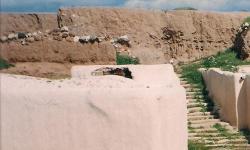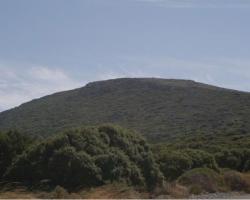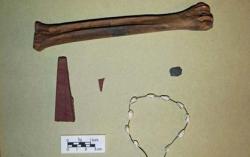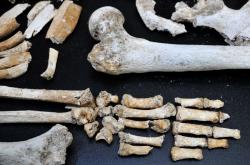INSTITUT SUPERIEUR D'ANTHROPOLOGIE
INSTITUTE OF ANTHROPOLOGY
ONLINE COURSES / COURS A DISTANCE
SPRING SESSION : APRIL 2013
REGISTER NOW
ROYAUME UNI –  Stanbury Hill - Evidence of life, possibly dating back 9,000 years, on Stanbury Hill on the edge of Bingley Moor, has been unearthed thanks to a community archaeology project investigating the site. Set up in 2008 and run and staffed by local volunteers, the Stanbury Hill Project was tasked with probing the prehistoric landscape which was characterised by “cup and ring marked” rocks – believed to date from the late Neolithic to early Bronze Age, around 2500 BC. As it draws to an end, project director Keith Boughey revealed that excavation has uncovered chert tools, made from a flint-like material, which could date from the Mesolithic period (or Middle Stone Age). The discovery of the tools means that hunter-gatherers were on the site 9,000 years ago, around 7000 BC. Dr Boughey, a retired teacher, said: “That we did not expect. It did not mean they lived up there but they were certainly there. We found clear evidence that human beings were on the hill in 7000 BC.” Following research that included the use of magnetism, electrical resistance and metal detecting to probe for remains under the ground, an area of just under 50,000 square metres of moorland revealed more than 200 different features. Excavation recovered charcoal, flint and chert tools, evidence of some form of agriculture, and several new examples of rock art. The charcoal originated from a mixture of tree species that suggested a date range of 1850-3350 BC and a deciduous woodland environment in a warmer climate than today, while radiocarbon dates from the western end of the site in the area of the excavations returned dates of 1905-1755 and 2035-1895 BC, firmly in the Bronze Age. Dr Boughey said: “The key thing is getting some dates. Those two dates coincide with the human evidence up there. We definitely have a prehistoric site up there; it is Bronze Age; 4,000 years ago there were people up there doing stuff.” As well as finding tools made of chert which is found locally, researchers found tools made of flint which had come from the Yorkshire Wolds, more than 100 miles away.
Stanbury Hill - Evidence of life, possibly dating back 9,000 years, on Stanbury Hill on the edge of Bingley Moor, has been unearthed thanks to a community archaeology project investigating the site. Set up in 2008 and run and staffed by local volunteers, the Stanbury Hill Project was tasked with probing the prehistoric landscape which was characterised by “cup and ring marked” rocks – believed to date from the late Neolithic to early Bronze Age, around 2500 BC. As it draws to an end, project director Keith Boughey revealed that excavation has uncovered chert tools, made from a flint-like material, which could date from the Mesolithic period (or Middle Stone Age). The discovery of the tools means that hunter-gatherers were on the site 9,000 years ago, around 7000 BC. Dr Boughey, a retired teacher, said: “That we did not expect. It did not mean they lived up there but they were certainly there. We found clear evidence that human beings were on the hill in 7000 BC.” Following research that included the use of magnetism, electrical resistance and metal detecting to probe for remains under the ground, an area of just under 50,000 square metres of moorland revealed more than 200 different features. Excavation recovered charcoal, flint and chert tools, evidence of some form of agriculture, and several new examples of rock art. The charcoal originated from a mixture of tree species that suggested a date range of 1850-3350 BC and a deciduous woodland environment in a warmer climate than today, while radiocarbon dates from the western end of the site in the area of the excavations returned dates of 1905-1755 and 2035-1895 BC, firmly in the Bronze Age. Dr Boughey said: “The key thing is getting some dates. Those two dates coincide with the human evidence up there. We definitely have a prehistoric site up there; it is Bronze Age; 4,000 years ago there were people up there doing stuff.” As well as finding tools made of chert which is found locally, researchers found tools made of flint which had come from the Yorkshire Wolds, more than 100 miles away.
http://www.yorkshirepost.co.uk/news/at-a-glance/general-news/volunteers-throw-new-light-on-prehistoric-moors-life-1-5585666
AZERBAIDJAN- Ganja - Egyptian archeologists have also proved that Ganja, the second largest city of Azerbaijan, is more than 4000 years old, deputy director for scientific affairs at the Azerbaijan National Academy of Sciences Ganja Scientific Center Samir Pishnamazzadeh told. He said the samples collected in Ganja under the leadership of director of the Library of Alexandria Ismail Serageldin have been taken to Archaeology Center, studies have started. “We have sent crafts, pottery samples and jewelries, which were collected by Hummer’s brothers in the Ganja River and kept at Ganja State Museum of Ethnography, to Egypt. Through analysis, Egyptian archaeologists confirmed that Ganja is more than 4,000 years old.” According to Samir Pishnamazzadeh, the first analysis on the age of Ganja city was carried out by the US Smithsonian Institution: “A sample was taken from the banding agent that fastened the stones of walls in Zurnabad area and sent to the Smithsonian Institution for chemical analysis. According to the results, it was found out that Ganja is 4,000 years old.” Pishnamazzadeh said that on April 25, an archaeological research team from the US will arrive in Azerbaijan and conduct studies on the age of the city.
http://en.apa.az/news_egyptian_archeologists_also_prove_ganja__191121.html
SYRIE –  Ebla - Seen from afar, Ebla in Syria is a mound rising above the Idlib plain. It was first settled more than 5,000 years ago. It eventually became a fortified walled city whose residents worshiped multiple gods, and traded olive oil and beer across Mesopotamia. The city was destroyed around 2200 B.C., flourished anew several centuries later and then was destroyed again. Now, in a test of time, Ebla is finding its military character once more, as, the way happened thousands of years ago, it is used by rebel Syrians as an observation post for passing government military planes, during the civil war destroying the country since 2011. For decades Ebla has been celebrated for the insights it offers into early Syrian civilization. The scenes here today offer something else: a prime example of a peculiar phenomenon of Syria’s civil war — scores, if not hundreds, of archaeological sites, often built and inhabited millenniums ago because of their military value, now at risk as they are put to military use once more. Apart from using Ebla as a natural watchtower, they say they try to protect it from full-on looting by thieves who want to sort through the place with earth-moving equipment, looking for artifacts to sell on the black market. Mr. Shibleh himself digs on the ancient mound, and he has explored its underground passages. He led the way on this day into a series of ancient crypts. “It is another country underground,” he says. In one section of tunnel, Mr. Shibleh found a large scoop-shaped piece of bone that appeared to be as light as a wafer. It had been part of a human head. “There were too many skulls,” he said. “The cave here was full of them.” Those skulls, he said, are now gone — removed by artifact hunters and then thrown away. Grave sites are potential spots to find jewelry or figurines, as some corpses were interred with offerings and possessions. This has made Ebla, like hundreds of other sites in a country that sometimes refers to itself as an open-air archaeological museum, a tempting spot for thieves. The meticulous excavation of Ebla’s ruins had continued in the decades since its famous tablet archive was unearthed, and layer by layer had turned up more artifacts. Archaeologists had left much of the site undisturbed, for careful sifting by future teams. They hoped for more finds. That methodical examination has recently been replaced by crude digging and crime. After Mr. Shibleh returned above ground, children were digging holes in the undisturbed sections of the mound, seeking more artifacts. Mr. Shibleh said some people also come to the site and haul away carloads of dirt from inside the tunnels; it is ideal, he said, for making the ceramic liner for bread-baking ovens.
Ebla - Seen from afar, Ebla in Syria is a mound rising above the Idlib plain. It was first settled more than 5,000 years ago. It eventually became a fortified walled city whose residents worshiped multiple gods, and traded olive oil and beer across Mesopotamia. The city was destroyed around 2200 B.C., flourished anew several centuries later and then was destroyed again. Now, in a test of time, Ebla is finding its military character once more, as, the way happened thousands of years ago, it is used by rebel Syrians as an observation post for passing government military planes, during the civil war destroying the country since 2011. For decades Ebla has been celebrated for the insights it offers into early Syrian civilization. The scenes here today offer something else: a prime example of a peculiar phenomenon of Syria’s civil war — scores, if not hundreds, of archaeological sites, often built and inhabited millenniums ago because of their military value, now at risk as they are put to military use once more. Apart from using Ebla as a natural watchtower, they say they try to protect it from full-on looting by thieves who want to sort through the place with earth-moving equipment, looking for artifacts to sell on the black market. Mr. Shibleh himself digs on the ancient mound, and he has explored its underground passages. He led the way on this day into a series of ancient crypts. “It is another country underground,” he says. In one section of tunnel, Mr. Shibleh found a large scoop-shaped piece of bone that appeared to be as light as a wafer. It had been part of a human head. “There were too many skulls,” he said. “The cave here was full of them.” Those skulls, he said, are now gone — removed by artifact hunters and then thrown away. Grave sites are potential spots to find jewelry or figurines, as some corpses were interred with offerings and possessions. This has made Ebla, like hundreds of other sites in a country that sometimes refers to itself as an open-air archaeological museum, a tempting spot for thieves. The meticulous excavation of Ebla’s ruins had continued in the decades since its famous tablet archive was unearthed, and layer by layer had turned up more artifacts. Archaeologists had left much of the site undisturbed, for careful sifting by future teams. They hoped for more finds. That methodical examination has recently been replaced by crude digging and crime. After Mr. Shibleh returned above ground, children were digging holes in the undisturbed sections of the mound, seeking more artifacts. Mr. Shibleh said some people also come to the site and haul away carloads of dirt from inside the tunnels; it is ideal, he said, for making the ceramic liner for bread-baking ovens.
http://www.archaiologia.gr/en/blog/2013/04/15/the-double-life-of-ebla/
GRECE –  Kythera - New evidence from the excavation that has been conducted at Leska peak on Mermigkari Mountain at the island of Kythera. The character of this site as a peak sanctuary during the Neopalatial period will be discussed in a local as well as in a wider insular framework. The topographic characteristics from Leska and the finds that were recovered from the research conducted at this site will be presented and their importance will be assessed accordingly. In particular, the finds will allow us to propose that different practices and rituals were conducted at the sanctuary, which will aid using the better understanding of the religious and symbolic beliefs associated with this site and more broadly with Kythera.
Kythera - New evidence from the excavation that has been conducted at Leska peak on Mermigkari Mountain at the island of Kythera. The character of this site as a peak sanctuary during the Neopalatial period will be discussed in a local as well as in a wider insular framework. The topographic characteristics from Leska and the finds that were recovered from the research conducted at this site will be presented and their importance will be assessed accordingly. In particular, the finds will allow us to propose that different practices and rituals were conducted at the sanctuary, which will aid using the better understanding of the religious and symbolic beliefs associated with this site and more broadly with Kythera.
http://www.archaiologia.gr/en/blog/2013/04/15/leska-a-new-peak-sanctuary-on-kythera/
FRANCE –  Bar sur Aube - Depuis deux semaines, Gilles Deborde et ses deux collègues réalisent des fouilles entre la route départementale et le quartier des Varennes, à l'entrée de Bar-sur-Aube. Dans le cadre du chantier de requalification du quartier, une voie romaine a été découverte : « Suite au projet mené par Mon Logis, les travaux ont révélé la présence de la voie gallo-romaine qu'on pensait en réalité sous la route départementale. Elle est finalement parallèle à la chaussée existante ». Les trois techniciens de l'Inrap ont effectué des décapages sur plusieurs niveaux : « Cette voie a été utilisée jusqu'au XVIIIe siècle puisqu'on constate plusieurs strates différentes correspondant aux différentes époques. Son emprise foncière, sa fosse de délimitation est de 35 mètres alors que la voie de roulement n'est que de 10 mètres. » Quant à savoir où elle conduit, le chef de chantier a déjà une réponse : « Cette voie antique épaisse était nommée voie de l'Océan. Elle reliait Milan à Boulogne-sur-Mer. La voie de l'Océan bifurque à Langres. Ici, nous sommes donc en présence de sa section orientale. C'était la voie principale qui, à l'époque, traversait la cité de Bar-sur-Aube. Nous ne connaissions pas sa structure avant cette découverte. L'intérêt pour nous est de l'étudier. Cela va nous permettre de mieux cartographier cette voie romaine », conclut Gilles Deborde.
Bar sur Aube - Depuis deux semaines, Gilles Deborde et ses deux collègues réalisent des fouilles entre la route départementale et le quartier des Varennes, à l'entrée de Bar-sur-Aube. Dans le cadre du chantier de requalification du quartier, une voie romaine a été découverte : « Suite au projet mené par Mon Logis, les travaux ont révélé la présence de la voie gallo-romaine qu'on pensait en réalité sous la route départementale. Elle est finalement parallèle à la chaussée existante ». Les trois techniciens de l'Inrap ont effectué des décapages sur plusieurs niveaux : « Cette voie a été utilisée jusqu'au XVIIIe siècle puisqu'on constate plusieurs strates différentes correspondant aux différentes époques. Son emprise foncière, sa fosse de délimitation est de 35 mètres alors que la voie de roulement n'est que de 10 mètres. » Quant à savoir où elle conduit, le chef de chantier a déjà une réponse : « Cette voie antique épaisse était nommée voie de l'Océan. Elle reliait Milan à Boulogne-sur-Mer. La voie de l'Océan bifurque à Langres. Ici, nous sommes donc en présence de sa section orientale. C'était la voie principale qui, à l'époque, traversait la cité de Bar-sur-Aube. Nous ne connaissions pas sa structure avant cette découverte. L'intérêt pour nous est de l'étudier. Cela va nous permettre de mieux cartographier cette voie romaine », conclut Gilles Deborde.
http://www.lest-eclair.fr/article/a-la-une/sous-le-chantier-de-requalification-la-voie-romaine
USA –  Fort Hunter - The Schoharie Crossing State Historic Site is the only place where all three stages of the 19th-century Erie Canal is presented, but the site recently added an 18th-century dimension to its collection. The flooding from Tropical Storm Irene unearthed limestone foundations of an 18th-century blockhouse on the grounds of the site. Among the stones and rubble, and in adjacent fields, state archaeologists have uncovered numerous artifacts of Native American and European origins. Among the artifacts are beads, pendants, gun flints, tools from stone called chert flake, musket balls, coins, creamware and porcelain.
Fort Hunter - The Schoharie Crossing State Historic Site is the only place where all three stages of the 19th-century Erie Canal is presented, but the site recently added an 18th-century dimension to its collection. The flooding from Tropical Storm Irene unearthed limestone foundations of an 18th-century blockhouse on the grounds of the site. Among the stones and rubble, and in adjacent fields, state archaeologists have uncovered numerous artifacts of Native American and European origins. Among the artifacts are beads, pendants, gun flints, tools from stone called chert flake, musket balls, coins, creamware and porcelain.
http://www.leaderherald.com/page/content.detail/id/555400/Unburied-Treasure--Schoharie-Crossing-plans-presentation-about-artifacts.html?nav=5011
ALLEMAGNE –  Alkersleben - The remains of some 70 people executed 700 years ago were found in a mound in eastern Germany, near the town of Alkersleben. Archaeologist Marita Genesis is studying the bones at the Thuringia State Office for the Preservation of Monuments. She has learned that one of the bodies had been tied up, one had been buried next to a strangulation chain, and a third had been buried with a sharp blade. “Some outlaws were hung so long by their necks that they decayed and fell down. Then they were contemptuously disposed of in unhallowed ground.
Alkersleben - The remains of some 70 people executed 700 years ago were found in a mound in eastern Germany, near the town of Alkersleben. Archaeologist Marita Genesis is studying the bones at the Thuringia State Office for the Preservation of Monuments. She has learned that one of the bodies had been tied up, one had been buried next to a strangulation chain, and a third had been buried with a sharp blade. “Some outlaws were hung so long by their necks that they decayed and fell down. Then they were contemptuously disposed of in unhallowed ground.
http://www.spiegel.de/international/zeitgeist/germany-sees-rising-interest-in-execution-site-archaeology-a-893747.html